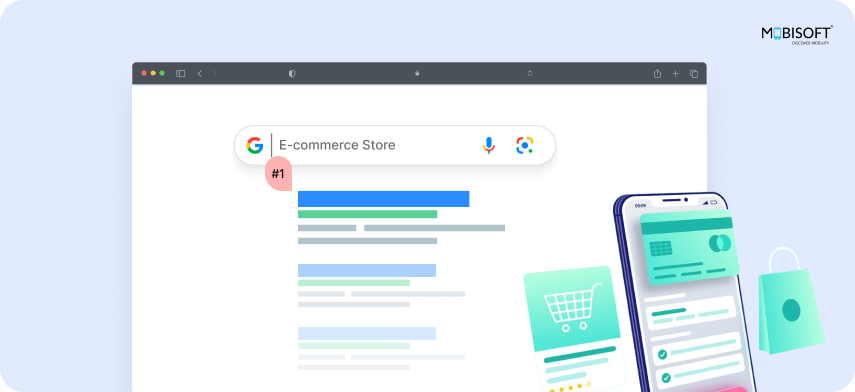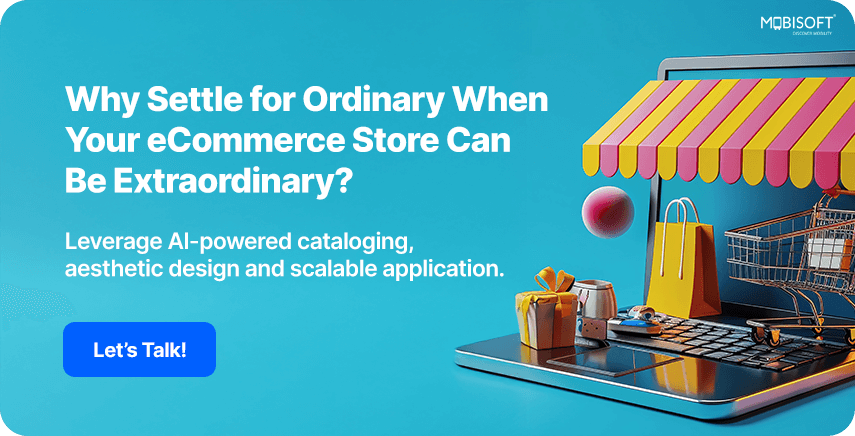You’ve poured your heart and soul into creating a fantastic e-commerce store. The design looks slick. Your products are amazing. And you’re ready for customers to flock in. But here’s the big question: When people search online for products like yours, can they actually find you?
In today’s crowded digital marketplace, just having a website isn’t enough. You need search engines to find your store. They must understand what you sell and show it to the right people at the right time. This is what e-commerce SEO is all about.
Think of SEO for e-commerce not as some mysterious dark art. It’s about making your online shop visible, trustworthy, and helpful to both search engines and potential customers. It paves a clear path from a user’s search to your product pages. At Mobisoft Infotech, we don’t just build online stores; we build them to be found. Because visibility is the bedrock of online success.
Let’s dive into practical ways you can optimize your e-commerce website to climb the search rankings and attract more paying customers.
Why Bother with SEO? (Hint: It's Crucial!)

Investing time and effort into SEO for online stores isn't just a "nice-to-have"; it's fundamental for several key reasons:
- High-Quality Traffic (For Free!): Unlike paid ads where you pay for every click, traffic from organic search results is essentially free. When someone searches for "waterproof hiking boots size 9," they have a clear intention to buy. Ranking well for relevant terms brings these highly motivated shoppers directly to you.
- Builds Trust and Credibility: Let's face it, we tend to trust businesses that appear high up in Google search results. Good rankings signal authority and reliability to potential customers.
- Sustainable Growth: While e-commerce SEO optimization takes effort, once you gain rankings, they can provide a steady stream of traffic and sales long after you've done the initial work, unlike ads that stop when the budget runs out.
- Stay Competitive: Your competitors are likely doing SEO for e-commerce. If you're not, you're effectively letting them capture customers who could have been yours.

Setting the Stage: A Solid Foundation Matters
Before you dig into SEO tips for e-commerce websites, make sure your website’s structure is solid:
- Choose an SEO-Friendly Platform: Pick an e-commerce platform that gives you control over SEO essentials like page titles, URLs, and descriptions. Bonus if it includes blogging tools, features that are fundamental to effective ecommerce site optimization.
- Logical Site Structure: Make it easy for visitors and search engines to navigate. Use clear categories and subcategories. For example: Homepage > Category Page > Subcategory Page (if needed) > Product Page. Think of it like clear aisles in a store. Simple and organized.
- Intuitive Navigation: Use straightforward menus. Add “breadcrumbs” like Home > Clothing > Men’s Shirts so users know where they are and can easily go back.
- Mobile-First is a MUST: Most online searches and shopping happen on smartphones now. Your site must be fast, smooth, and easy to use on mobile devices. Google favors mobile-friendly sites in rankings. This isn’t optional, it's a critical e-commerce SEO best practice.
For a deeper dive into setting up a performance driven platform, check out our complete guide on How to Build a Scalable eCommerce Website (Guide).
The Headless Advantage for SEO
Modern setups like Headless Commerce separate the frontend from the backend, offering several benefits for SEO for e-commerce sites.
- Lightning Speed: Headless allows developers to build incredibly fast, lightweight frontends using modern tools. Site speed is a critical ranking factor (think Google's Core Web Vitals), and headless architectures often make achieving top speed scores much easier than traditional platforms.
- Total Customization Control: You get complete freedom over URL structures, page layouts, and how content is presented, enabling precise e-commerce SEO optimization without being restricted by backend templates or limitations. A major advantage when building a custom ecommerce solution is that it supports SEO from the ground up.
Your SEO Toolkit: Optimizing Your Digital Storefront

With a solid foundation, let’s get to the specific actions from your e-commerce SEO checklist.
Keyword Research: Speak Your Customer's Language
- What it is: Figuring out the actual words and phrases people type into Google when looking for products you sell.
- How to do it (simply): Put yourself in your customer's shoes. What would you search for? Brainstorm terms. Use tools like Google Keyword Planner (free) or more advanced paid tools (like Ahrefs, SEMrush) to find related keywords, see how many people search for them (search volume), and how competitive they are. Look for both broad terms ("running shoes") and more specific, "long tail" keywords ("best trail running shoes for flat feet").
- Where to use them: Weave these keywords naturally into your page titles, headings, product descriptions, and category page text. Important: Don't just stuff keywords everywhere. It looks spammy and hurts user experience. Write for humans first, search engines second.
Nail Your Product Pages (Where Sales Happen!)
- Compelling Page Titles: Include the main keyword, product name, maybe a key feature, and your brand (e.g., "Sony WH-1000XM5 Noise Cancelling Headphones - Black | YourStore"). Keep them clear and concise (ideally under 60 characters).
- Enticing Meta Descriptions: This is your brief ad in the search results (around 150-160 characters). Make it persuasive, include keywords naturally, and give people a reason to click on your link.
- Unique, Helpful Product Descriptions: Do not just copy/paste manufacturer descriptions! Write your own engaging copy. Focus on benefits, answer potential questions, use keywords naturally, and make it easy to read (use bullet points!).
- Optimize Your Images: Use high quality product photos. Give image files descriptive names (e.g., sony-wh1000xm5-headphones-black.jpg instead of IMG_7890.jpg). Crucially, use descriptive "Alt Text" for each image. This tells search engines what the image shows and helps visually impaired users using screen readers.
- Encourage Customer Reviews: Reviews are SEO gold! They provide fresh, unique content related to your products (which Google loves), build trust, and help customers make decisions.
To make sure your store is equipped for performance, don’t miss our checklist of 9 Must-Have eCommerce Features for a Successful Store.
Optimize Category Pages Too
- These pages are vital for ranking for broader search terms (e.g., "wireless headphones").
- Give them clear, keyword optimized titles and descriptions.
- Consider adding a brief, helpful introductory paragraph describing the category.
- Ensure the products displayed are relevant and the page is easy to browse/filter.
Technical Tune-Up: Under the Hood Essentials
- Site Speed: Slow sites hurt conversions and rankings. Use Google’s PageSpeed Insights to test your speed and get tips. Optimize images, enable browser caching, and reduce unnecessary code. Headless architectures can help here.
- Secure Connection (HTTPS): Your whole site must use HTTPS (look for the padlock icon). This ensures security, builds trust, and improves rankings.
- Schema Markup (Structured Data): This adds hidden labels to your content, helping search engines understand your site better. It can show rich snippets in search results, like star ratings or prices, boosting clicks. Many platforms offer built-in schema or plugins.
- Clean House: Use Google Search Console regularly. Fix broken links (404 errors) and other technical issues that hurt SEO and user experience.
Build Authority with Links (Off-Page SEO)
- What it is: Earning links from other reputable websites back to your store. Search engines view these links as "votes of confidence," boosting your site's authority.
- How to get them (the right way): Focus on quality over quantity. Create amazing content (blog posts, guides, infographics) that people naturally want to link to. Reach out to relevant bloggers or industry sites. Get listed in reputable business directories. Avoid spammy link building tactics!
A great example of leveraging SEO and digital transformation to expand internationally is outlined in our case study on a Fashion Retailer’s Online Transformation for Global Reach.
Content Marketing: Be More Than Just a Store
- Consider adding a blog to your e-commerce site. Write helpful articles, guides, tutorials, or comparisons related to your products or industry (e.g., "How to Choose the Best Noise Cancelling Headphones," "Gift Guide for Music Lovers").
- This attracts potential customers searching for information (not just products), establishes your expertise, gives people something valuable to link to, and keeps your site fresh.
Measuring Your Success: Know What's Working

You need to track your e-commerce SEO efforts to see what's paying off:
- Google Analytics: Monitor your overall website traffic, see how much comes from organic search, which pages visitors land on, how long they stay, and most importantly, track sales (conversions) from organic traffic.
- Google Search Console: See which search terms are actually bringing people to your site, monitor your keyword rankings over time, submit your sitemap (a map of your site for Google), and identify technical SEO issues.
Tracking your SEO for e-commerce websites helps you understand which pages and strategies are driving results. Keep an eye on your rankings for target e-commerce SEO keywords, the volume of organic traffic, and the revenue generated from that traffic.
SEO = Profitability: Connecting the Dots

How does optimizing for search engines actually make you more money? It's a clear chain reaction:
- Better Rankings -> More Visibility: Your store appears higher in search results, where more people will see it.
- More Visibility -> More Relevant Clicks: People actively searching for what you sell are more likely to click on your link.
- More Relevant Clicks -> More Qualified Traffic: You attract visitors who are genuinely interested in your products.
- More Qualified Traffic -> Higher Conversion Rates: Interested visitors who find what they need easily are much more likely to make a purchase.
- Higher Conversions -> Increased Revenue & Profit: This high quality, often "free" traffic drives sustainable business growth.
Think about the most successful online retailers, big or small. From giants like Amazon to thriving niche stores, they almost universally have a strong e-commerce SEO foundation. Their teams follow an e-commerce SEO checklist, optimizing every facet of their site, from speed to structure to content , because they know it’s a direct path to increased profitability.
Conclusion: SEO is a Journey, Not a Destination
SEO for your e-commerce site isn’t a one time task. It’s a continuous effort. Algorithms change. Competitors grow. Customer search habits shift.
Focus on the basics:
- Build a fast, mobile-friendly site
- Maintain a clear structure
- Strengthen your product and category pages
- Publish helpful, keyword-rich content using proven e-commerce SEO best practices
- Monitor progress using your favorite e-commerce SEO tools and techniques
Keep improving. Whether that’s refining your on-page SEO or expanding your strategy through ecommerce app development to engage mobile shoppers more effectively. Over time, this turns your site into a valuable business asset that consistently ranks well and drives qualified traffic.
Need help getting started or improving your SEO setup?
Mobisoft Infotech builds scalable, SEO ready e-commerce platforms that boost visibility and drive measurable results. Let’s talk about how we can help your store grow.





 May 19, 2025
May 19, 2025


